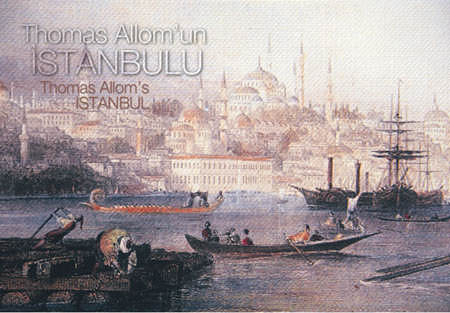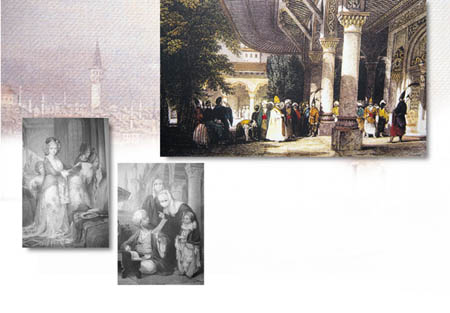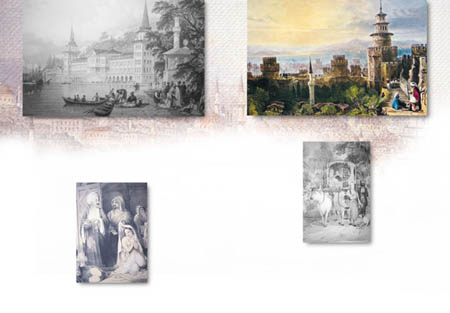THOMAS ALLOM'S ISTANBUL
 Istanbul
is a city steeped in the history of ages, with a myriad stories to tell. Travellers to the
city in Ottoman times were captivated by its silhouette of domes and slender minarets
against the reddening sky as the sun sank into the Marmara Sea. Poets, unrequited lovers,
those at odds with their own country, and those in search of adventure were drawn here.
They smoked water pipes with firemen in coffee houses on the Golden Horn, wandered through
the Hippodrome, took rowing boats along the Bosphorus, breathed in the seaweed scented sea
air from Çamlıca Hill, drank ice cold water from a fountain in Mahmut Paşa, and
explored the colourful labyrinthine streets of the Covered Bazaar. Istanbul
is a city steeped in the history of ages, with a myriad stories to tell. Travellers to the
city in Ottoman times were captivated by its silhouette of domes and slender minarets
against the reddening sky as the sun sank into the Marmara Sea. Poets, unrequited lovers,
those at odds with their own country, and those in search of adventure were drawn here.
They smoked water pipes with firemen in coffee houses on the Golden Horn, wandered through
the Hippodrome, took rowing boats along the Bosphorus, breathed in the seaweed scented sea
air from Çamlıca Hill, drank ice cold water from a fountain in Mahmut Paşa, and
explored the colourful labyrinthine streets of the Covered Bazaar.
This golden city, gateway to east and west, where thousands of years of history could
be glimpsed through the mists of time, attracted people from far and wide into its
irresistible web of mystery. Among them were many who sought to depict and describe this
city they came to love, so that they and their companions would never forget it, and to
show others what they had seen. Armed with pens, pencils, notepads and sketch books they
explored every corner of Istanbul, alias Constantinople. They drew, painted, and described
whatever they saw, leaving behind a record of the city of unsurpassed detail in art and
literature.
 One of the
most famous artists who recorded Istanbuls evocative scenes in his engravings was the
Englishman Thomas Allom. He was an architect by profession, but it is for his engravings
of Istanbul that he is best remembered today. As a young man, inspired by the Orientalist
movement of his time, he came to this mysterious city and was carried away by the magical
atmosphere of the East. His engravings depict every part of the city, from Yeniköy on the
Bosphorus to the fortress of Yedikule, and are today invaluable documentary records of
Istanbul in the 1830s. One of the
most famous artists who recorded Istanbuls evocative scenes in his engravings was the
Englishman Thomas Allom. He was an architect by profession, but it is for his engravings
of Istanbul that he is best remembered today. As a young man, inspired by the Orientalist
movement of his time, he came to this mysterious city and was carried away by the magical
atmosphere of the East. His engravings depict every part of the city, from Yeniköy on the
Bosphorus to the fortress of Yedikule, and are today invaluable documentary records of
Istanbul in the 1830s.
Allom was born in London in 1804 and studied at the Royal Academy. His designs for
churches shown at exhibitions in 1824 and 1827 aroused considerable interest in this young
man who showed such promise as an architect so early in his career. But Alloms longing
to travel and depict what he saw were to lead him in another direction, to become an
artist with the analytical eye of an architect. First he travelled and sketched his way
around England, and then went to Scotland. Next he travelled to France and Belgium, where
again he produced a series of beautiful landscapes. The flame of his desire to travel
continued to burn unceasingly, and carried him this time to the distant land of China on
the other side of the world.
After returning, Allom remained for a while in England, but then set out on his travels
again, this time to Istanbul, which he had long dreamed of visiting, and from there to the
Holy Land. In 1834, at the age of 30, he arrived in Istanbul, and until 1836 travelled
through Anatolia, Syria and Palestine, producing hundreds of lovely drawings. Shelving his
ambitions as an architect for the time being, he became one of the most renowned
Orientalist artists of his time.
 During his
stay in Istanbul, Thomas Allom was warmly received by the British ambassador Lord
Strangford. Accompanied by the Reverend Robert Walsh, chaplain to the embassy and a
knowledgeable scholar of Turkeys ancient and modern history, Allom explored the city.
His picturesque engravings provide a rich array of detailed information about the
architectural texture of Istanbul at that time and the daily life of its inhabitants. He
drew scenes of the Bosphorus and Golden Horn, the citys cemeteries, Sultanahmet Square
and its environs, churches and sacred springs, the city walls, coffee houses, and Turkish
baths. In his engravings we see many buildings which have not survived to the present day,
or have come down to us in altered form. During his
stay in Istanbul, Thomas Allom was warmly received by the British ambassador Lord
Strangford. Accompanied by the Reverend Robert Walsh, chaplain to the embassy and a
knowledgeable scholar of Turkeys ancient and modern history, Allom explored the city.
His picturesque engravings provide a rich array of detailed information about the
architectural texture of Istanbul at that time and the daily life of its inhabitants. He
drew scenes of the Bosphorus and Golden Horn, the citys cemeteries, Sultanahmet Square
and its environs, churches and sacred springs, the city walls, coffee houses, and Turkish
baths. In his engravings we see many buildings which have not survived to the present day,
or have come down to us in altered form.
Many of the lovely waterfront houses on the Bosphorus depicted in Alloms engravings
have now been replaced by tall concrete blocks. In Alloms time Kızkulesi (Maidens
Tower) on an islet at the mouth of the Bosphorus was a wooden structure, and off
Ahırkapı there were net fisheries. No trace remains today of Esirci Han (Khan of the
Slave Traders) in the Slave Market in Nuruosmaniye.
From Istanbul Thomas Allom travelled to Bursa, and from there southwards through the
Aegean region to Manisa, Pergamum, Ephesus and Pamukkale. He then turned eastwards and
travelled through Syria and finally to Palestine.
In 1838 Constantinople and the Scenery of the Seven Churches of Asia Minor was
published in two volumes, written by Robert Walsh and illustrated by Thomas Allom.
Subsequently this book was translated into French and published in three volumes by Leon
Gallibert and Clement Pelle in Paris. Emily Reeves Character and Costume in Turkey
and Italy, published in London in 1840, was also illustrated with engravings by Thomas
Allom.
Thomas Allom did eventually become a successful architect as well as artist. He
executed a series of paintings for the chateau of King Louis Philippe in Dreux, designed
the Church of Christ in Highburg in 1850, and the Church of St Peter in Notting Hill in
1856. He won first prize in a competition held in Oxford for a conservatory which he
designed and built. Allom was also one of the founders of the Institute of British
Architects.
Thomas Allom died in Barnes on 21 August 1872, never to be forgotten as one of the
artists whose name has been inscribed in golden letters in the history of Istanbul.
Generation after generation have marvelled at his engravings, which so faithfully record
the Istanbul of his time.
|